 Right now, twenty people are being physically abused by an intimate partner.i One minute ago, twenty other people were being abused and in one minute from now, another twenty people will be abused.
Right now, twenty people are being physically abused by an intimate partner.i One minute ago, twenty other people were being abused and in one minute from now, another twenty people will be abused.
This equates to more than ten million victims of physical domestic violence and intimate partner abuse every year in the United States.ii
Despite the staggering statistics on domestic violence and intimate partner abuse, there was a dramatic decline in rates of domestic violence after 1994.
So what happened to cause this decrease? In 1994, the Violence Against Women Act was passed and signed into law by then President Bill Clinton.iv
The Violence Against Women Act was signed into law by then-President Bill Clinton in September 1994.v The Act served several purposes, including bringing more attention to the issues of domestic violence, dating violence, sexual assaults, and stalking – largely grouped as intimate partner violence.
In addition to raising awareness of these issues, the Act changed the laws to allow for more protections of the victims of intimate partner violence.vi Although the Act is called the Violence Against Women Act, it allows for protections of all victims of domestic violence and sexual assaults, regardless of gender; however, over 85% of victims of intimate partner violence are women.vii
The passage of the Violence Against Women Act was a game-changer in terms of funding many aspects of intimate partner violence research, prevention, protection, and prosecution.viii It also made gender-based violence a hate crime, allowing it to be prosecuted federally and with harsher punishments, including harsher punishments for repeat sexual offenders.ix
The Violence Against Women Act created grant programs for prevention, investigation, prosecution, and research of intimate partner violence.x It also authorized grant funding for youth education, the National Domestic Violence Hotline, and battered women’s shelters, some of which had already been funded through allocations from the Family Violence Prevention and Services Act.xi In later years, reauthorizations of the FVSPA continued the funding of the National Domestic Violence Hotline and some shelters.
The Violence Against Women Act was originally authored as Title IV of the Violent Crime Control and Law Enforcement Act, also signed into law in 1994. The Violent Crime Act was designed to help law enforcement fight violent crimes, as well as giving victims of violent crimes more services. VAWA was later introduced to Congress by Senators Barbara Boxer and Joe Biden. The purpose of creating VAWA as its own act rather than a title of separate act was to raise awareness of family and domestic violence and give it the attention and spotlight that is needed for such a serious and pervasive issue.xii
In their remarks to Congress, Senators Boxer and Biden addressed the insufficiencies of law enforcement and prosecutorial responses to intimate partner violence and the need for attitudes and viewpoints to change.xiii In 1994, the rates of domestic violence were even more staggering than they are today. The Bureau of Justice Statistics calculates that in 1994, there was 9.8 victimizations per 1,000 people, with over 80% of the victims of intimate partner violence being women.xiv
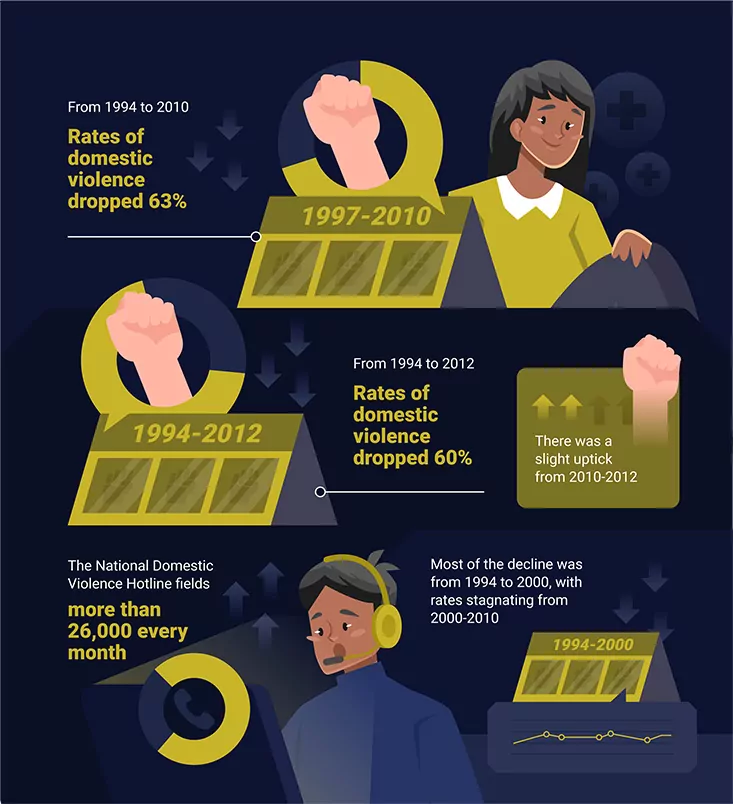
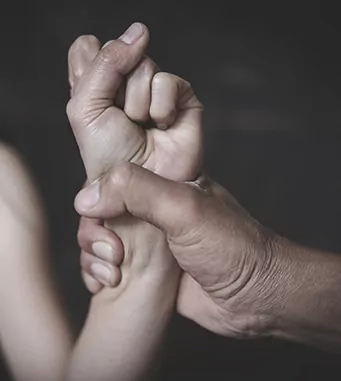
Intimate Partner Violence decreased 48% from 1994 to 2000, when the VAWA was first up for reauthorization in Congress.xvThe funding and protections of the original act were set to expire in 2000, meaning that it had to go through Congress again, be passed again, and signed again, in order to continue funding the myriad programs and protections that the Act originally funded.xvi
As with any good law that keeps up with current requirements and issues, the Act was expanded with each subsequent passage. The 2000 reauthorization strengthened the protections for immigrants, sexual assault victims, and victims of dating violence.xvii
It also strengthened interstate enforcements of protective orders and made it easier for victims of domestic violence to cross state lines for purposes of custody without returning to a location where they may be in danger of further violence.xviii
Perhaps the most significant expansion of the Violence Against Women Act in the 2000 reauthorization, however, was the added protections for tribal residents. The 2000 reauthorization created the Tribal Domestic Violence and Sexual Assault Coalitions Grant Program, which provided funding for all sorts of programs to help end domestic violence and sexual assault within Native American and Alaska Native communities.xix
The Tribal DV and SA Coalitions Grant Program funds programs that increase awareness of intimate partner violence within these communities, enhances services provided to Native victims of domestic violence, and enhance the response to domestic violence at every level. xx Funding for and increased protections of intersectional minorities is critical – while over 80% of domestic violence partners are women, the rates increase drastically for women of color.xxi
It’s estimated by the National Institute of Justice that nearly 85% of American Indian or Alaskan Native women have experienced physical violence, over 56% have experienced sexual violence, and over 55% have experienced physical violence specifically at the hand of an intimate partner. xxii At the time of the original passage and first reauthorization both, a legal loophole made it nearly impossible for tribes and reservations to prosecute non-Indians for crimes committed against American Indian and Alaska Native women, xxiii making the Tribal Coalitions Grant program incredibly vital and almost revolutionary in nature.
The 2000 reauthorization also created the Battered Immigrant Women Protection Act, which allowed further protections for immigrant victims of family violence who cooperated with and assisted law enforcement.xxiv
While the original text of VAWA did have some provisions for immigrants, the 2000 reauthorization truly deepened those protections. Specifically, the Battered Immigrant Women Protection Act created the U Visa, specifically for victims who cooperated with law enforcement.
However, while Congress was reauthorizing and expanding the Violence Against Women Act, the Supreme Court of the United States was limiting it in U.S. v. Morrison .xxv The petitioner in this case was a young woman who had been raped by three students at Virginia Polytechnic Institute (“Virginia Tech”) and was suing under the theory that the Violence Against Women Act provided a federal civil remedy for the victims of gender-based violence under 42 U.S. § 13981.
The respondents argued that the federal civil remedy was unconstitutional under both the Commerce Clause and the Fourteenth Amendment. In a decision authored by Chief Justice Rehnquist, the Supreme Court struck down the federal civil remedy, finding that the impact on interstate commerce was not enough to give Congress authority to create a federal civil remedy for gender-based violence. The Court specifically states,
“[g]ender-motivated crimes of violence are not, in any sense of the phrase, economic activity. While we need not adopt a categorical rule against aggregating the effects of any noneconomic activity in order to decide these cases, thus far in our Nation’s history our cases have upheld Commerce Clause regulation of intrastate activity only where that activity is economic in nature.”xxvi
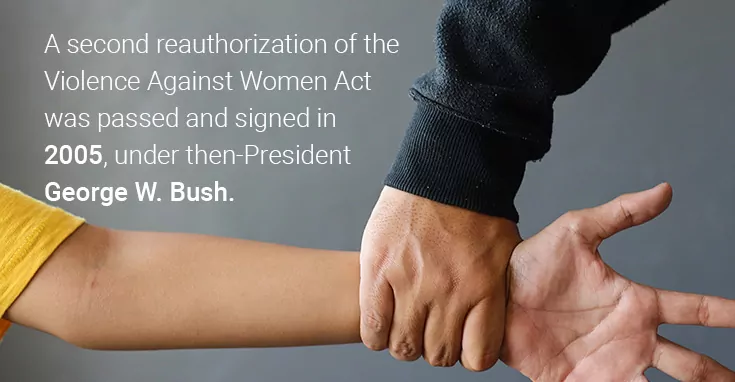
This second reauthorization again expanded the Act and its funding even further.
It continued to set aside and even increased funds for tribal governments, developing training for domestic violence service providers, requires funds to be set aside for underserved populations, authorized the use of grant funds for forensic sexual assault examinations, and prohibited officials from requiring sexual assault victims to submit to polygraph examination before an investigation or prosecution could continue.xxviii
In addition to increasing the grant funds for tribal governments, the 2005 reauthorization also authorized funding for the development of programs for HIV testing of sexual assault perpetrators and noticing victims of the test results, including dating violence, sexual assault, and stalking as serious criminal offenses, and developing registries of protection orders. These registries were to allow victims to be better protected in all jurisdictions.
As with every new reauthorization, definitions were expanded and new amendments were made in order to keep up with research on what constitutes domestic violence and what can be done to better protect victims. The 2005 reauthorization specifically amended the federal crimes code to double penalties for repeat domestic violence or stalking offenses; increase criminal penalties for stalking; define dating partner; and apply prohibitions on domestic violence and protection orders to include the special maritime and territorial jurisdictions.
It also amended the federal judicial code to expand the definition of protective order so that it included restraining, support,, custody, or visitation orders and orders that protected victims of dating violence, sexual assault, or stalking.xxix
The 2005 reauthorization also began to see how technology could impact domestic violence – specifically, stalking. This reauthorization amended the Communications Act to apply prohibitions against cyberstalking, or stalking via the internet. xxxThis was only the first change to take technology into account, and later reauthorizations will see new protections for “revenge porn” and other internet-based crimes.
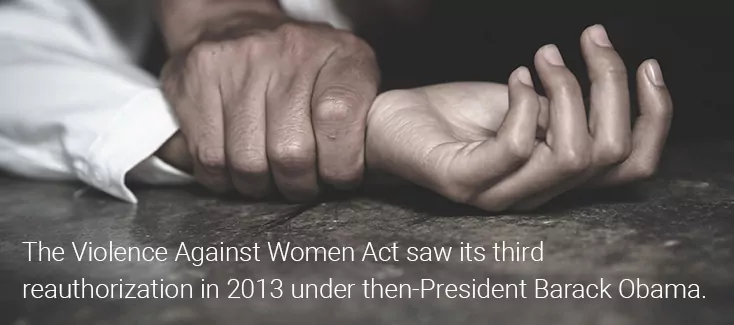
Again, the act was expanded to include more protections for intersectional identities and underserved populations.
The Act also defined certain key terms for the first time, including culturally specific services, personally identifying information or personal information, underserved populations, and youth.
This reauthorization also saw stricter grant conditions, specifically around the disclosure of personally identifying information and audit requirements. Other modifications to grant conditions included those around nonprofit organizations and civil rights.xxxi
STOP grants, or grants for the purpose of combating violent crime against women, were expanded in this reauthorization. STOP grants following the 2013 passage could be used to training of law enforcement and prosecutors, addressing backlogs of sexual assault evidence collection kits (“rape kits”), and provided greater protections for male victims of sexual assaults.xxxii
As with any other form of federal funding, there are some requirements that a state must meet in order to be eligible for STOP grant funding – a state must develop and submit implementation plans to the Attorney General, and new auditing requirements mean that the plan has to be followed.
Requirements for the plan include training programs with respect to domestic violence and sexual assaults, developing best practice for response to domestic violence and sexual assault crimes, creating or enhancing sexual assault nurse examiner programs and sexual assault response teams, providing HIV testing programs, and identify and inventorying backlogs of rape kits. At least 25% of funds were required to be used for projects addressing sexual assaults specifically, and at least 5% must be allotted for Indian tribal governments.xxxiii
This reauthorization specifically provided protections for male victims of sexual assaults, as well as defining “underserved populations.” That definition is, “populations that fac e barriers in accessing and using victim services because of geographic location, religion, sexual orientation or gender identity.” While VAWA was never exclusive to women victims, this is the first passage of the act that specifically called out gender identity, sexual orientation, or male victims. Additionally, the 2013 passage defined “’youth’ to mean a person who is 11 to 24 years old.” Again, this is the first passage that had any specifications as to age.xxxiv
This iteration of VAWA also saw more protections for internet-based crime through its amendment of the federal crimes code. This amendment related to stalking and prohibited the use of electronic or computer-based communications to stalk victims. 2013 also specifically strengthened protections against violent crimes, particularly sexual assaults, on college campuses.
Grant programs were expanded to provide educational materials on prevention and intervention in domestic violence, dating violence, sexual violence, and stalking and allowed grant recipients to develop or adapt specific strategies for underserved populations on college campuses.
Additionally, the disclosure requirements of campus safety and crime statistics were expanded to protect students by requiring education programs to promote awareness of sexual violence, require disclosure of disciplinary proceedings and the requisite standard of evidence around sexual violence, and establish procedures to protect the rights of accusers and accused persons in such disciplinary proceedings.xxxv
An incredibly significant change in 2013 was Title X – the Sexual Assault Forensic Evidence Reporting Act (SAFER). This passage was introduced for the purpose of eliminating the backlog of rape kits and involved special funding to governments for auditing samples of rape kits awaiting testing and ensuring that rape kits are collected and processed
“in an appropriate and timely manner and in accordance with specified protocols and practices.”
It requires reporting to the Department of Justice every sixty days with updates on the backlogs and the total number of samples submitted for testing.xxxvi
Another significant amendment created “special domestic violence criminal jurisdiction” (SDVCJ) in certain Tribal communities. xxxvii This gave Tribal governments criminal jurisdiction over non-Indian offenders. This began to close the loophole addressed earlier, and it would be addressed further in the 2022 reauthorization.
Other changes in 2013 included additional protections for immigrant women, programs to combat human trafficking, enhanced criminal penalties for assaults on persons under 16 and for assault by strangulation or suffocation, including sex trafficking as a target of grants to Indian tribal governments, and rights to housing for victims of domestic violence, dating violence, sexual assault, and stalking. xxxviii
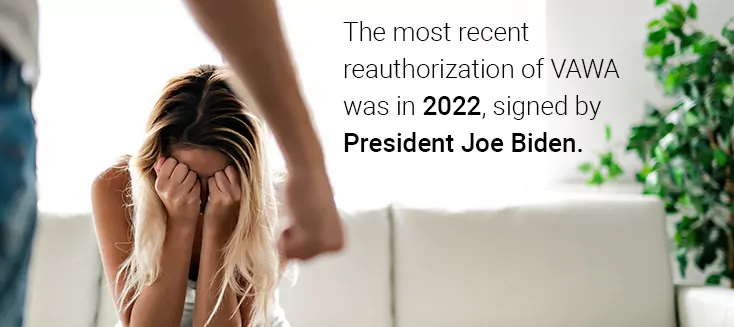
As a senator, President Biden was one of the sponsors of the original bill in 1994, thus bringing the Act full circle, in a way.
This current VAWA is enacted until 2027, when it will be brought for reauthorization again. xxxix The 2022 reauthorization faced opposition and criticism for its support of LGBTQ+ victims and survivors and its expanded provision of firearm protection. xl
This opposition resulted in a four-year delay between the lapse of the 2013 authorization and the passage of the 2022 authorization. xli
The expanded firearm protection was an attempt to close what has been known as the “boyfriend loophole.” While married partners convicted of domestic violence have not been permitted to own firearms, there was no such provision protecting unmarried victims of domestic violence. xlii This loophole was closed in 2022, and anybody convicted of domestic violence, dating violence, sexual assault, or stalking is now prohibited from owning firearms.xliii
Earlier iterations created special criminal jurisdiction of Tribal courts: 2022 expanded this jurisdiction to cover non-Native persons committing sexual assault, child abuse, stalking, sex trafficking, and assaults on law enforcement officers on tribal land. xliv Similarly, a pilot project was developed to enhance access to safety for victims of gender-based violence, domestic or family violence, stalking, and sexual violence in Alaska Native villages. This program is similar to the SDVCJ courts in Tribal governments. xlv
Further protections for internet-based actions were implemented once again in the 2022 reauthorization, including for persons whose intimate images are disclosed without consent and cyberstalking. The National Resource Center on Cybercrimes Against Individuals was created in 2022 and supports efforts of state, local, and Tribal governments to prevent and prosecute cybercrimes.
Further strengthened protections and access for victims included more support and services for underserved populations and rural communities, expansion of prevention education in higher education, enhanced training for sexual assault forensic examiners, programming to help children to have been exposed to domestic violence, and increasing support for the Rape Prevention and Education Program and the Sexual Assault Services Program.xlvi
Additionally, the support for victims of sexual assault who were and are impacted by the rape kit backlog was increased. The 2022 reauthorization enacted the Fairness for Rape Kit Backlog Survivors Act. This requires state victim compensation programs to allow survivors of sexual assaults to file for compensation without being unfairly penalized due to rape kit backlogs.xlvii
This unfair penalization could include things like prosecution not being initiated due to lack of evidence because of the backlog – or prosecution never occurring at all if a rape kit is never tested.
A key component of VAWA was the funding of programs and services for victims of domestic violence, sexual violence, dating violence, stalking, and other gender-based violence. The Act requires a coordinated community response to domestic violence, stalking, and sexual assault, which involves people from different backgrounds and experiences coming together to share information and improve responses.
These people can include prosecutors, police officers, judges, victim advocates, probation officers, corrections officials, health care professionals, faith leaders, and victims and survivors of gender-based violence. VAWA grants fund shelters and crisis response centers all across the nation, help train law enforcement officers and probation officers, allow prosecution offices to have dedicated staff for gender-based violence and victim advocates, and help train healthcare professionals, especially in things like sexual assault forensic examinations.
xlviii
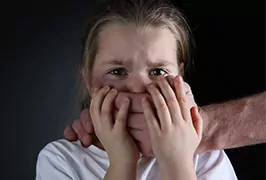
VAWA created the Office on Violence Against Women (OVW), a component of the Department of Justice, in 1994.
The purpose of the OVW is to administer financial and technical assistance to facilitate the creation of all of the training programs, policies, and practices aimed at ending gender-based violence or supporting victims of gender-based violence.xlix It’s a largely administrative office that was intended to implement not only the 1994 VAWA, but also all future reauthorizations.l
Since 1994, the OVW has awarded approximately four billion dollars in VAWA grant funds. These funds have gone to state, tribal, and local governments as well as non-profit organizations focused on ending violence against women, and universities. li In 2002, the OVW was made a permanent part of the Department of Justice.
Its director must be Senate-confirmed after a Presidential appointment. lii The OVW also provides resources for applicants and recipients of grants, helps to manage grant funds, and authors reports to Congress. liii
The official mission of the OVW is to, “provide[] federal leadership in developing the national capacity to reduce violence against women and administer justice for and strengthen services to victims of domestic violence, dating violence, sexual assault, and stalking. liv” In Fiscal Year, 750 grants were awarded, totaling $488 million dollars in funds.
In 2009, the American Recovery and Reinvestment Act was passed and signed by then-President Barack Obama. One of myriad programs that received additional funding through this act was VAWA. This Act provided an additional $225 million dollars in grants to combat violence against women, to be administered by the OVW.
Of this, $50 million was to be used for transition housing assistance grants for victims of domestic violence, stalking, or sexual assault.lv

 Oklahoma has the highest rates of domestic violence for both women and men, with over 49% of women being victims and over 40% of men.lix
Oklahoma has the highest rates of domestic violence for both women and men, with over 49% of women being victims and over 40% of men.lix South Dakota has the lowest rate of domestic violence for women (over 27%)
South Dakota has the lowest rate of domestic violence for women (over 27%) North Dakota has the lowest rate for men (18.5%)lx.
North Dakota has the lowest rate for men (18.5%)lx.The most common risk factors for becoming a victim of domestic violence are having less education, being an adolescent or young adult, being female, living in a high-poverty neighborhood, being low income, and being dependent on drugs or alcohol. lxiThat said, domestic violence does not discriminate and anybody can become victim to domestic violence.
Race, ethnicity, and sexual orientation also impact the likelihood that one will become a victim of domestic violence or sexual assault. While 35% of white women and 35% of heterosexual women will become a victim of domestic violence, those rates increase quickly when other factors are considered. For example, 61% of bisexual women and 44% of gay women are victims of domestic violence.
Race also factors into that, with 37% of Hispanic women, 44% of Black women, 46% of American Indian women, and 54% of multiracial women becoming victims of domestic violence. 28% of white men are victims of domestic violence, and 29% of straight men are victims. Again, we see race and sexual orientation playing a role, with 37% of bisexual men and 26% of gay men becoming victims of domestic violence.
When race is accounted for, 26% of Hispanic men, 39% of Black men, 39% of multiracial men, and 45% of American Indian men are victims of domestic violence. Black members of the LGBTQ+ community are more likely to experience physical intimate partner violence than those who do not identify as Black, while white members of the LGBTQ+ community are more likely to experience sexual violence than those who do not identify as white.
Delving even deeper into intersectionality and victimization, those members of the LGBTQ+ community who are on public assistance are more likely to become victims of domestic violence than those who are not on public assistance. lxiiWhen looking at these statistics, it’s clear why VAWA continuously sets aside funding for underserved communities, tribal governments, and community and culturally aware programming.
Domestic Violence Rates by Gender and Sexual Orientation:
35% of white women and 35% of heterosexual women experience domestic violence.
The rates increase significantly for other groups:
For men:
Domestic Violence Rates by Race:

Further factors include disabilities and being a child victim or witness. Women with disabilities were 40% more likely to experience severe physical intimate partner violence than those without disabilities, and 40% of child abuse victims reported experiencing domestic violence themselves.lxiii
When firearms and domestic violence mix, a deadly situation is created. 4.5 million women in the United States have reported being threatened by a partner with a gun. 57 women are shot and killed by an intimate partner every month. A gun being present in a domestic violence situation increases the risk of homicide by over 500%, and women are more likely to be killed by an intimate partner with a gun than every other mean of homicide combined.
Women in the United States are also 11 times more likely to be killed with a gun than in any other high-income country.lxiv This is why the “boyfriend loophole,” allowing people convicted of domestic violence against an unmarried partner own a gun, was a point of contention in the 2022 reauthorization, and why it was critical that this loophole was closed.
We can’t discuss the domestic violence rates without also discussing the Covid-19 Pandemic. Rates of domestic violence increased significantly during the pandemic lockdowns for the first time since the 1994 passage of the Violence Against Women Act. Victims were locked in with their abusers with nowhere to go and no way to escape. Since people were also not meeting in person, it was almost impossible for a third-party to notice domestic violence and intervene.lxv
These increased rates of domestic violence were apparent in the increased calls to police for domestic violence –
 Portland observed a 22% increase in calls relating to domestic violence
Portland observed a 22% increase in calls relating to domestic violence New York observed a 10% increase in the same.lxvi
New York observed a 10% increase in the same.lxviFinally, leaving an abusive situation is the most dangerous time for a victim. 75% of domestic violence homicides occur after a separation. This isn’t just a dangerous time for victims, either – 20% of homicides relating to intimate partner violence were homicides of family members, friends, neighbors, people who attempted to intervene, and law enforcement.lxvii
Again, this demonstrates why services including advocacy, shelter, and counseling for victims are so critical and why VAWA continues to fund these programs to the tune of millions of dollars annually.
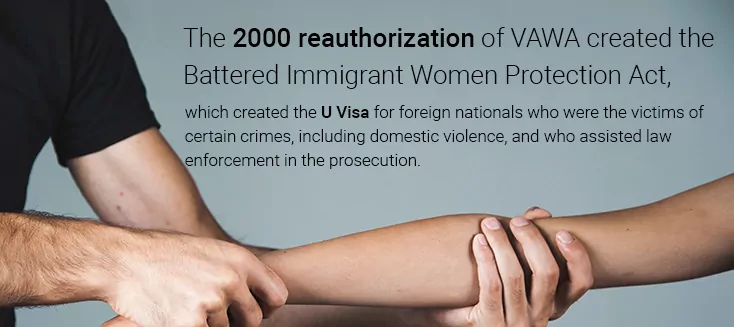
Provisions in VAWA also allowed victims of domestic violence to petition for lawful permanent resident (LPR, or “green card”) status without the sponsorship of a U.S. Citizen or LPR-holder.lxix
AWA petitions for LPR status have certain requirements that must be met.
If the petitioner is a spouse, they must demonstrate that they entered the marriage in good faith and not for the immigration benefits, resided with their U.S. citizen or LPR holder partner or spouse, and that they are a person of good moral character.lxx
Children petitioning for LPR status must demonstrate the relationship to the U.S. citizen or LPR parent, that they reside with the abusive parent, and show good moral character for children over age 14. An immigrant parent must demonstrate abuse by a U.S. citizen son or daughter, that they reside with the abusive son or daughter, and show their good moral character.lxxi
From 1997n to 2011, 75% of total VAWA petitions for green cards were approved, with some years being as low as 67% (1998, 2008) and some as high as 85% (2002). lxxiiIn 2013, the limit for VAWA green cards was raised from 10,000 to 18,000 annually.
One can turn to countless sources of media depicting sexual violence, domestic violence, dating violence, and stalking. Netflix has dozens of documentaries, docuseries, and docudramas on the topic. Law and Order: SVU is dedicated to sexual and gender-based violence. It can be shown in books, movies, songs, television shows, and by scrolling any number of social media sources. It’s a prevalent, endemic problem, and it needs to be addressed.
The Violence Against Women Act is one way that the government is facing the problem head-on and repeatedly. Funds for shelters, counseling, victim services, advocacy, law enforcement and prosecution training, community awareness, and prevention are just one way that the problem is being addressed and managed. As society grows, adapts, and changes, VAWA adapts with it.
2027 will see a new version of VAWA on the floor of Congress, and it will be fascinating to see what the future version will contain.
1 https://ncadv.org/statistics
2 https://ncadv.org/statistics
3 https://bjs.ojp.gov/content/pub/pdf/ipv9310.pdf
4 https://crsreports.congress.gov/product/pdf/R/R45410
5 https://www.britannica.com/event/Violence-Against-Women-Act
6 https://www.britannica.com/event/Violence-Against-Women-Act
7 https://bjs.ojp.gov/content/pub/pdf/ipv9310.pdf
8 https://www.britannica.com/event/Violence-Against-Women-Act
9 https://www.britannica.com/event/Violence-Against-Women-Act
10 https://crsreports.congress.gov/product/pdf/R/R45410
11 https://crsreports.congress.gov/product/pdf/R/R45410
12 https://crsreports.congress.gov/product/pdf/R/R45410
13 https://crsreports.congress.gov/product/pdf/R/R45410
14 https://bjs.ojp.gov/content/pub/pdf/ipv9310.pdf
15 https://bjs.ojp.gov/content/pub/pdf/ipv9310.pdf
16 https://www.ncai.org/tribal-vawa/about-vawa/2000
17 https://www.ncai.org/tribal-vawa/about-vawa/2000
18 https://www.ncai.org/tribal-vawa/about-vawa/2000
19 https://www.ncai.org/tribal-vawa/about-vawa/2000
20 https://www.ncai.org/tribal-vawa/about-vawa/2000
21 https://bjs.ojp.gov/content/pub/pdf/ipv9310.pdf
22 https://nij.ojp.gov/topics/articles/violence-against-american-indian-and-alaska-native-women-and-men
23 Oliphant v. Suquamish Indian Tribe (1978)
24 https://crsreports.congress.gov/product/pdf/R/R42477
25 U.S. v. Morrison, 529 U.S. 598 (2000)
26 U.S. v. Morrison, 529 U.S. 598, 613 (2000)
27 https://www.congress.gov/bill/109th-congress/house-bill/3402
28 https://www.congress.gov/bill/109th-congress/house-bill/3402
29 https://www.congress.gov/bill/109th-congress/house-bill/3402
30 https://www.congress.gov/bill/109th-congress/house-bill/3402
31 https://www.congress.gov/bill/113th-congress/senate-bill/47
32 https://www.congress.gov/bill/113th-congress/senate-bill/47
33 https://www.congress.gov/bill/113th-congress/senate-bill/47
34 https://www.congress.gov/bill/113th-congress/senate-bill/47
35 https://www.congress.gov/bill/113th-congress/senate-bill/47
36 https://www.congress.gov/bill/113th-congress/senate-bill/47
37 https://www.justice.gov/tribal/2013-and-2022-reauthorizations-violence-against-women-act-vawa
38 https://www.congress.gov/bill/113th-congress/senate-bill/47
48 https://www.legalmomentum.org/history-vawa
49 https://www.legalmomentum.org/history-vawa
50 https://www.legalmomentum.org/history-vawa
51 https://www.legalmomentum.org/history-vawa
52 https://www.legalmomentum.org/history-vawa
53 https://www.justice.gov/ovw
54 https://www.justice.gov/ovw
55 https://niwaplibrary.wcl.american.edu/wp-content/uploads/2015/VAWA-Gov-ARRA-2009hr1enrbill.pdf
56 https://bjs.ojp.gov/content/pub/pdf/ipv9310.pdf
57 https://bjs.ojp.gov/content/pub/pdf/ipv9310.pdf
58 https://bjs.ojp.gov/content/pub/pdf/ipv9310.pdf
59 https://www.dolanzimmerman.com/domestic-violence-statistics/
60 https://www.dolanzimmerman.com/domestic-violence-statistics/
61 https://www.dolanzimmerman.com/domestic-violence-statistics/
62 https://www.dolanzimmerman.com/domestic-violence-statistics/
63 https://www.dolanzimmerman.com/domestic-violence-statistics/
64 https://www.dolanzimmerman.com/domestic-violence-statistics/
65 https://www.dolanzimmerman.com/domestic-violence-statistics/
66 https://www.dolanzimmerman.com/domestic-violence-statistics/
67 https://www.dolanzimmerman.com/domestic-violence-statistics/
68 https://crsreports.congress.gov/product/pdf/R/R42477
69 https://crsreports.congress.gov/product/pdf/R/R42477
70 https://crsreports.congress.gov/product/pdf/R/R42477
71 https://crsreports.congress.gov/product/pdf/R/R42477
72 https://crsreports.congress.gov/product/pdf/R/R42477